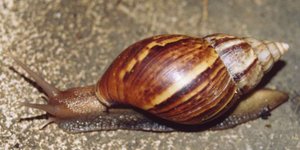Crabs, Snails & Algae Eaters
The name snail applies to most members of the molluscan class Gastropoda that have coiled shells. Other gastropods, which lack a conspicuous shell, are commonly called slugs, and are scattered throughout groups that primarily include snails. more...
Snails are found in freshwater, marine, and terrestrial environments. While most people are familiar with only terrestrial snails, the majority of snails are not terrestrial. Snails with lungs belong to the group Pulmonata, while those with gills belong to the Paraphyletic group.
Physical characteristics
Snails move like worms by alternating body contractions with stretching, with a proverbially low speed. They produce mucus in order to aid locomotion by reducing friction. The mucus also reduces the snail's risk of injury and helps keep away potentially dangerous insects like ants. When retracted into their shells, snails secrets a special type of mucus which dries to cover the entrance of their shells with a 'trapdoor' like structure called an operculum. This is similar to some slug species which build a shell-like object below their upper skin to prevent drying out. The operculum of some snails has a pleasant scent when burned, so it is sometimes taken and used as incense.
In winter or in dry seasons, some snail species hibernate in their shells by building the operculum, which they build only for the purpose of protection while hibernating and are destroyed in spring or when their surroundings becomes wetter. Some species would gather and hibernate in groups while others would bury themselves before hibernating.
Snails come in a range of different sizes. The largest land snail is the Giant African Snail (Achatina achatina; Family Achatinidae), which can measure up to 30 cm. Pomacea maculata (Family Ampullariidae), or Giant Apple Snail is the largest freshwater snail, with its size reaching 15 cm diameter and over 600 g weight. The biggest of all snails is Syrinx aruanus, a marine species living in Australia. Shell lengths up to 1 m have been reported.
Snail shells, like those of the Nautilus, are one example of the appearance of the phi, the golden ratio, in nature. Patterns on shells of certain sea snails (Conus, Cymbiola) are formed by biological version of cellular automata.
As the snail grows, so do their shells. A snail will close off a section of their shell and add a new chamber as it grows larger, each chamber being larger than the previous one by a constant factor. As a result, the shells forms a logarithmic spiral. At some point, a snail would build a lip around the opening of their shell, and when that happens, they would stop growing and start spending their energy and effort reproducing.
Snail shells and egg casings are made up of primarily calcium carbonate like other mollusk's shells. Because of this, they require a decent amount of calcium in their diet and watery enviroment to produce a strong shell. A lack of calcium, or if the pH level of their surrounding starts fluctuating, would likely cause their shells to be thin, crack, or have holes. Usually a snail can repair its shell damage over time if their living conditions improve, but some damage could be severe enough to be fatal for the snail.
Read more at Wikipedia.org


